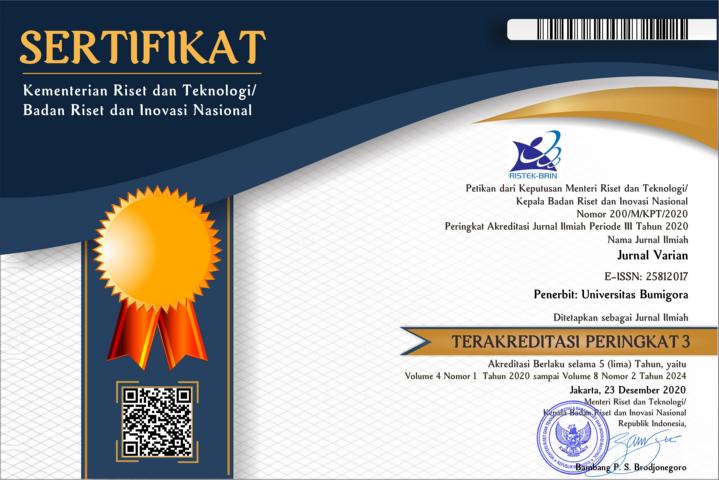Network Optimization of Packaging Water Factory "Aeta" by Using Critical Path Method (CPM) in Tirta Taman Sari Drinking Water Company, Madiun City
Abstract
Project management is a new thing with the development of two analytical techniques used for planning, scheduling, and decision making on projects to be carried out so that they can be carried out optimally and efficiently. These two analytical techniques are the Critical Path Method (CPM) and Project Evaluation and Review Technique (PERT). Network optimization for the project is very important for the production of with "Aeta" brand Bottled Mineral Water produced by drinking water company in Madiun. This optimization is carried out in order to find out the production schedule of bottled water, there are 4 packages produced namely cups, 1.5 L bottles, 600 ml bottles, and gallons. After scheduling using the Critical Path Method, ie bottled water production will be more profitable if more products are in Gallon packaging. Because the Gallon packaging will save time this happens because the Gallon packaging does not go through cardboard packaging.
References
Chen, K., Si, J., Zhou, F., Zhang, R., Shao, H., & Zhao, H. (2015). Optimization of air quantity regulation in mine ventilation networks using the improved differential evolution algorithm and critical path method. International Journal of Mining Science and Technology, 25(1), 79–84.
Chen, S.-P. (2007). Analysis of Critical Paths in a Project Network with Fuzzy Activity Times. European Journal of Operational Research, 183(1), 442–459.
Hunter, P. R., MacDonald, A. M., & Carter, R. C. (2010). Water Supply and Health. PLoS Medicine, 7(11), 1–10.
Jéquier, E., & Constant, F. (2010). Water as an Essential Nutrient: The Physiological Basis of Hydration. European Journal of Clinical Nutrition, 64(2), 115–123.
Kopanos, G. M., Kyriakidis, T. S., & Georgiadis, M. C. (2014). New Continuous-Time and Discrete-Time Mathematical Formulation for Resource-Constrained Project Scheduling Problems. Computers and Chemical Engineering, 68(2), 96–106.
Kyriakidis, T. S., Kopanos, G. M., & Georgiadis, M. C. (2012). MILP Formulations for Single- and Multi-Mode Resource-Constrained Project Scheduling Problems. Computers and Chemical Engineering, 36(1), 369–385.
Mazlum, M., & Güneri, A. F. (2015). CPM, PERT and Project Management with Fuzzy Logic Technique and Implementation on a Business. Procedia - Social and Behavioral Sciences, 210(1/2), 348–357.
Nagata, M. F., Manginelli, W. A., Lowe, J. S., & Trauner, T. J. (2018). Delay Analysis Using Critical Path Method Schedules. In Construction Delays.
Nicholas, J. M., & Steyn, H. (2020). Project Management for Engineering, Business and Technology. In Project Management for Engineering, Business and Technology. Routledge.
Pankaj, R. D., Kumar, A., & Agarwal, R. (2020). Energy Efficient Path Determination in Wireless Sensor Network by Critical Path Method. Malaya Journal of Matematik, 8(3), 797–802.
Sahoo, R. R., & Ray, M. (2020). PSO Based Test Case Generation for Critical Path Using Improved Combined Fitness Function. Journal of King Saud University - Computer and Information Sciences, 32(4), 479–490.
Shankar, N., Sireesha, V., & Rao, P. (2010). An Analytical Method for Finding Critical Path in a Fuzzy Project Network. International Journal of Contemp Math Science, 5(20), 953–962.
Susana, T. (2003). Air Sebagai Sumber Kehidupan. Oseana, 28(3), 17–25.
Takakura, Y., Yajima, T., Kawajiri, Y., & Hashizume, S. (2019). Application of Critical Path Method to Stochastic Processes with Historical Operation Data. Chemical Engineering Research and Design, 149(1/2), 195–208.
Ubar, R., Kostin, S., Jenihhin, M., Raik, J., & Jürimägi, L. (2018). Fast Identification of True Critical Paths in Sequential Circuits. Microelectronics Reliability, 81(2), 252–261.
Wang, J., Wu, J., Wu, J., Yang, Y., Xiong, Z., Niu, Y., … Hughes, D. (2005). Critical Path. PEI Power Engineering International, 13(6), 105–111.
Zareei, S. (2018). Project Scheduling for Constructing Biogas Plant Using Critical Path Method. Renewable and Sustainable Energy Reviews, 81(1), 756–759.


















